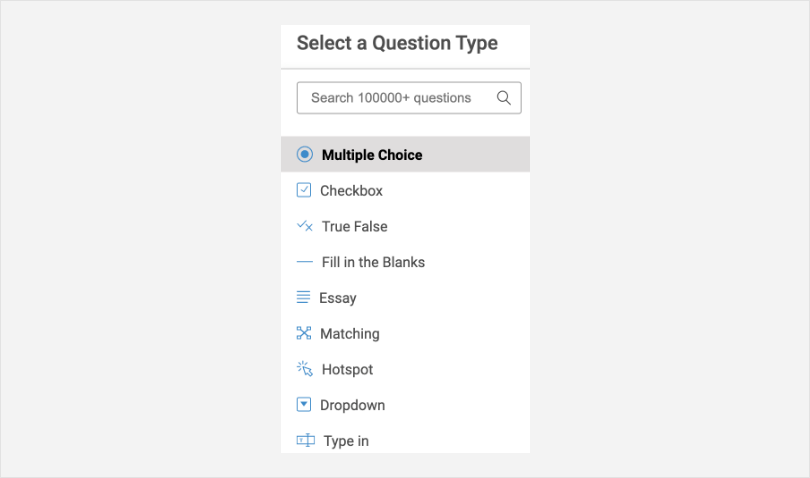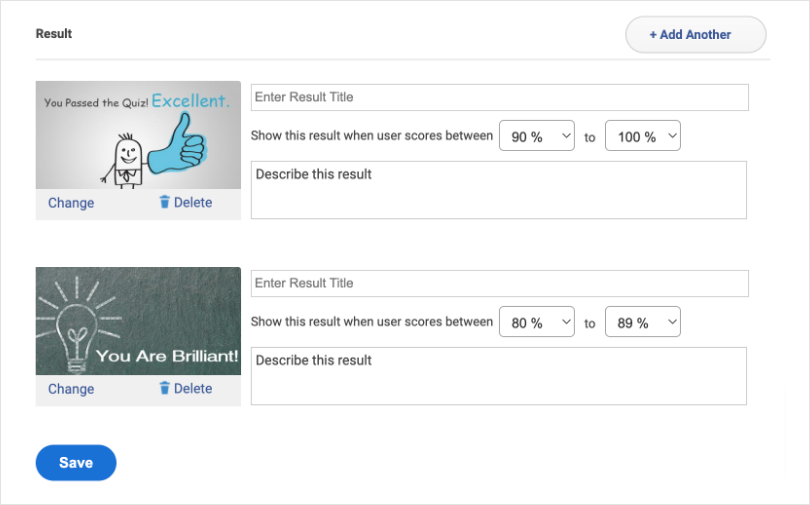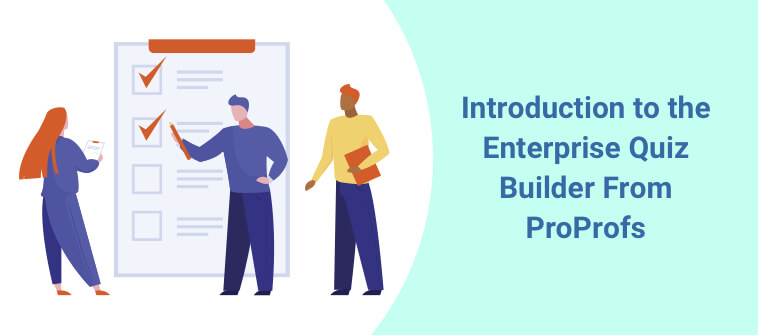Delivering impactful learning isn’t easy, right?
You have to succeed in several aspects to take learners on a smooth journey from where they are to where they must be. These include understanding and engaging learners and ensuring knowledge comprehension and retention.
With interactive quizzes, you can easily pull this off!
How?
Here’s a quick example.
As hard as I may try, I can’t remember the definition of a term I came across in a course I took last week. But I still remember the answer to the question that prevented me from getting the first prize in a science quiz in 9th grade.
I also clearly remember the answer to the question that made someone a millionaire on the show “Who Wants To Be a Millionaire” years ago.
![Kevin Olmstead's $2.18 Million Dollar Question - Who Wants to be a Millionaire [Classic Format]](https://i.makeagif.com/media/5-02-2016/ufBSv7.gif)
Do you see what’s common about the information that’s still fresh in my memory?
It’s that in both instances, the information was from a quiz. Frankly, it feels as if I’ve taken mental snapshots of those questions and their answers.
In this blog post, we’ll understand how to leverage interactive quizzes to enhance learning and the steps to create an effective quiz that can make learning effective for your learners.
Let’s dive in.
How to Enhance Learning With Interactive Online Quizzes
Online quizzes are an effective way to enhance learning by engaging students in interactive and personalized activities. This section will explain how online quizzes can help students learn better.
1. Evaluate Existing Knowledge Levels
You need to assess what learners already know to identify the gaps you need to address. For example, if you want to provide training to your employees, interactive quizzes in the form of pre-training assessments can help you.
By establishing what your learners need to master, you can customize your learning material to deliver a personalized and targeted learning module.

What You Can Do
- Create a short quiz with 10-15 questions related to your topic. Assign it to your learners and analyze the quiz report.
If most of your learners have a weak understanding of a topic you viewed as a critical prerequisite, you may provide an extensive session on it. - If most learners have higher levels of knowledge in a topic you plan to cover, you may decide to drop it and replace it with another one they have not learned yet. Or, adjust the level of complexity or time you spend on it.
2. Engage Learners to Boost Comprehension & Retention
You may already know that repetitive reading is a common method for knowledge retention.
Simply reading the same thing repeatedly and expecting better retention may appear like a good enough learning practice, but honestly, who’s got the time to read something a thousand times?
This is where online quizzes can help. When created with engaging questions, it can translate into better engagement and boost retention.
What You Can Do
- Add different types of quiz questions, such as true and false, MCQs, essay types, matching, hotspot, and more.
- Keep your questions short and to the point.
- Create fun interactive quizzes and make them engaging by adding audio, visuals, and texts.
- Provide feedback for every answer or feedback based on scores.
- Also, add images and videos to your feedback for more engagement.
Watch: Question Types for Online Learning & Assessment
3. Track & Analyze Learning Progress
According to research, the average person forgets about 70% of what they hear or read immediately after taking it in.
Just teaching a course or lesson won’t tell you how much was understood and retained by your learners, but quizzing will.
Traditional tests may require reproducing essay-like answers to check knowledge retained from a lesson.
Online quizzes can create a rich experience for learners by framing questions in different formats to challenge the learners’ ability to reason, comprehend, and think creatively to arrive at the answers.
- The quick format, instant feedback, and easy personalization of such quizzes to suit any learning style make them the perfect choice to check how much a learner finally understands after a lesson or course.
- An interactive online quiz motivates learners to participate actively in the process and engage in the course material by looking at a piece of information in the form of visuals, audio, or text.
- Unlike traditional tests that can be high stakes and lengthy, such interactive quizzes can be presented as soon as a bite-sized lesson is over to build knowledge retention over the long term.
What You Can Do
Create a quiz based on the lesson you’ve just taught and assign it to your learners. Make sure to do the following:
- Automate the grading process for quick score analysis
To make the quiz more engaging and fast-paced, you can automate the grading process and show the scores or grades instantly after each submission. This will maintain the learners’ curiosity and motivation.
Watch: How to Automate Quiz Scoring & Grading
4. Create a Feedback Loop
Interactive quizzes that provide feedback on learners’ responses can help create a learning loop.
Adding feedback for incorrect answers turns something disappointing into a learning opportunity. Plus, it improves the learning experience by making it more interactive.
Prof. Gosling from the University of Texas touches upon this in his research. He believes that students with poorer college preparation could benefit from constant feedback.
Feedback triggers instant knowledge evaluation, ensuring no waste of time. Once you update learners with their results, they can run a self-analysis to find out which areas they struggle with and go back to revising topics they’re weak in.
What You Can Do
You need to do more than just mark an answer correct or incorrect. You need to connect the questions to the learning outcomes and provide feedback that enhances the learners’ understanding.
You can do this by providing instant answer explanations or attaching links to courses and other online resources in your feedback.
For example, in a marketing quiz, if a student gets the answer wrong about a particular topic, you can frame your feedback like this:
“Oops! That’s a wrong pick. Revisit the topic “Brand Management” and attempt again.”


You can provide different, personalized feedback to each learner via text, video, or audio.

Make sure your feedback is specific and relevant to the learning objectives, not vague or general. For example, instead of saying, “Good job,” say something like, “You did well on identifying the main idea of the text.”
5. Gauge Individual Learning Ability
When you create interactive quizzes online using quiz maker software, all the reports are auto-generated, and the results are stored on a cloud-based system. These reports provide additional insights, such as:
⇒ Time spent on each question
⇒ Number of right and wrong answers
⇒ Total time taken to complete the quiz
This data can help you gauge individual learning ability. You can compare it with previous data to see if the learners have progressed. You can also use this data to help learners self-assess.
What You Can Do
- Create learner groups and reassign quizzes.
You can create different learner groups in an online classroom based on the analysis from the quiz reports and assign different quizzes and courses to different groups.
For example, you can create a learner group with the highest number of incorrect answers or a group with incorrect answers only from a certain part of the topic.
To adapt the course/lesson to the needs of the trainees or students, you can make a quiz for each group targeting the questions they previously got wrong. You can repeat this process until the trainees or students reach the expected level of performance. This process will improve their retention and mastery of the content.
Watch: How to Set up Your Virtual Classroom
6. Address Different Learning Styles
Learning styles vary among students. They learn differently depending on how they perceive and process information. Some are visual learners, some are auditory learners, and some are verbal learners. But not every teaching method is compatible with each learning style. What benefits one learner may not benefit another.
Online interactive quizzes can help address different learning styles by providing variety, customization, and multimedia support.
What You Can Do
- Use a mix of question types in your interactive quizzes, such as hotspot, drag-and-drop, multiple-choice, fill-in-the-blanks, matching, and more.
- Add a video & audio track to your quiz questions to increase learner engagement with formative assessments and improve learning outcomes.
- Add images and videos to quiz questions & answers.
Here’s an example of an image-based quiz for improving language skills:
Related Read: How to Create a Learning Style Quiz
Now that you know how you can use interactive quizzes to boost learning, let’s look at how you can create such quizzes online.
Steps to Create an Interactive Quiz Online
In this section, you’ll get an overview of the steps you need to follow to create an interactive quiz for students or employees.
Watch: How to Create an Online Quiz in Under 5 Minutes
Step 1: Create From Scratch or Use a Readymade Template
There are two ways to create an interactive quiz. You can create your quiz from scratch or customize a pre-designed template to suit your requirements.
Starting with a readymade template can be amazing if you’re on a tight schedule and want your quiz ready to be deployed in minutes.
For example, if you’re using ProProfs Quiz Maker to create your interactive quiz, you can pick:
- a professionally designed scored quiz template
- a training assessment from the assessment library
- a ready-to-use quiz from the question bank

Preview the quizzes related to your topic and click the “Use This…” button once you’ve landed on one you like. If you’d rather build your quiz from the ground up, click “Create From Scratch”.
Either way, you’ll reach the quiz editor. You can start building your interactive quiz by setting up your quiz cover. Click “Edit Cover” to add/change your quiz’s title, cover image, and description.


Step 2: Add Questions or Import From a Question Library
You can add, modify, or delete questions. To add new questions, click “Add Question.”

Select a question type from the overlay and write the question statement and answer options. Repeat till you’ve added enough questions to your interactive quiz.

Alternatively, you can browse the question bank using the search bar on top and import questions. You can import questions from multiple quizzes in a single go!

?♂️Pro Tip:
Make sure your quiz has a good mix of closed and open-ended question types to make it highly engaging. Also, try including highly interactive question types, such as hotspot, video-response, order-the-list, drag-and-drop, etc.
Step 3: Add Images & Feedback
Another way to make your quizzes engaging is by adding images/videos to your quiz questions/answer options. Click the image icon next to a question statement or answer option to add media from Google, YouTube, etc., or upload your own.

You can also present a video and ask questions based on it.
Watch: How to Create a Video Quiz
Also, as mentioned before, providing instant feedback in your interactive quizzes can work wonders in enhancing interactivity and learning. For example, check out the image-based feedback in this question:

As you can see, you can provide:
- A common feedback
- Different feedback for correct & incorrect answering
- Separate feedback for each answer option.

Step 4: Automate Scoring & Certification
The best interactive quiz makers let you automatically grade your quizzes and make the results instantly available to learners. To automate grading, you’ll need to assign scores to questions and answer options.
Go to the quiz’s settings, locate “Score & Time” in the ‘General’ tab, and select how you want to grade your quiz.


Watch: How to Automate Grading in Online Quizzes
Once you’ve set up your quiz’s scoring, you can customize the results screen. You can present different messages to quiz takers based on their total scores and automatically award them custom certificates.


Awarding great-looking custom certificates can improve learner engagement and inspire learners to pursue self-learning.
Watch: How to Create & Award Custom Quiz Certificates
Step 5: Enable Security and Anti-Cheating Settings
By now, you’ve already designed an interactive and engaging quiz tailored for learning. But your efforts may not provide the intended results if learners decide to cheat. Fortunately, you can discourage cheating by configuring some settings.
For example, you can enable proctoring to monitor test takers via screen sharing and webcam video recording.
The proctoring log in the quiz report will let you check if the quiz taker has used any unfair means to answer questions.
Other anti-cheating settings include:
- Disabling tab/browser switching
- Randomizing question and answer option order
- Using question pooling to present a different question set to each learner
- Making your tests password-protected and granting access via individualized logins or single sign-on
Watch: How to Configure Your Quiz Settings
And that’s it. Your quiz is ready to be deployed to support and enhance your teaching or training initiatives.
Quizzes are powerful tools for learning, but not all quizzes are created equal. Some quizzes are boring or confusing, while others are fun and rewarding. How can you make sure your quizzes fall into the latter category?
Let’s find out in our next section.
Best Practices for Creating Interactive Quizzes
Here are some best practices to help you create interactive quizzes that your learners will love.
1. Align Quizzes With Learning Objectives
Make sure your quizzes match the learning goals and outcomes you want to achieve. Use quizzes to assess, reinforce, or enhance the knowledge or skills you have taught or want to teach.
2. Design Engaging and User-Friendly Quizzes
Ensure your quizzes are fun for your learners. Here’s how you can do it:
- Use clear and concise language.
- Keep an appropriate difficulty level and a reasonable time limit.
- Avoid ambiguous, misleading, or trivial questions or options.
- Give your learners clear and specific instructions on how to take the quiz
- Avoid making your quiz too long to ensure learners remain engaged throughout.
- Use various question types.
- Add an attractive theme to your quiz featuring a background image related to the topic.
Watch: How to Design Beautiful Quizzes
3. Incorporate Multimedia and Interactive Elements
Add images, videos, and audio clips to make your quizzes more stimulating. Use interactive elements such as drag-and-drop, matching, hotspot, or ordering questions, timers, and instant feedback to make your quizzes dynamic and interactive.
Read: How to Add a Drag-and-Drop Question to Your Quiz
5. Craft Upbeat Results
Use positive language in the quiz results. Upbeat results can motivate learners to learn more and better by boosting their confidence and curiosity.
For example, instead of saying, “You scored 60% on this quiz. You need to study more.”, you can say, “You scored 60% on this quiz. You have a good grasp of the basics, but you can do even better. Here are some tips and resources to help you improve.”
6. Ask Situation-Based Questions
Situation-based questions are excellent for measuring how well someone can apply their knowledge and skills in real-life scenarios. They are especially useful for employee assessments that require practical judgment. You can combine them with instant feedback to create amazing learning opportunities.

7. Use a Top-Notch Quiz Tool
To make your online quizzes more effective for learning, you need a quiz tool that meets your needs and preferences. Your quiz tool should allow you to create customized quizzes quickly and easily.
It should provide all essential and advanced features and provide great support. Watch the video below to discover the features that make an interactive quiz tool ideal for learning.
Watch: How to Choose the Best Quiz Software
Importance of Interactive Quizzes in Learning
Learning is not a passive process. It requires active participation, engagement, and feedback from the learners.
One of the most effective ways to achieve this is by using interactive quizzes in your learning materials. They can be used for various purposes, such as:
- Assessing the learners’ prior knowledge, progress, or mastery of a topic.
- Reinforcing the key concepts, facts, or principles that the learners have learned.
- Motivating the learners to pay attention, stay focused, and challenge themselves.
- Enhancing the learners’ retention, recall, and transfer of information.
- Engaging the learners in a fun and interactive way that stimulates their curiosity and interest.
Many findings support the notion that online quizzes play an impactful role in learning. Let’s take a look.
1. Daily Online Testing in Large Classes
In their research study titled ”Daily Online Testing in Large Classes,” the professors at the University of Texas observed that ”giving brief online quizzes at every class meeting in an introductory psychology class boosted student performance.’‘
2. Online Quizzes to Enhance Student Learning
Prof. Syed Muhful Aziz of the University of South Australia undertook a project titled ”Online Quizzes for Enhancing Student Learning in a First-Year Engineering Course”. His findings revealed that “online quizzes provide students with supplementary self-paced interactive learning resources.”
“Students can attempt the quizzes repeatedly until they have a clear understanding of the underlying concepts,” it said.
“Students appreciate the flexibility and action-oriented learning style of online quizzes.” This, he says, enables students to learn anytime and anywhere.
3. The Effects of Tests on Learning and Forgetting
In a research study titled “The Effects of Tests on Learning and Forgetting” conducted at the University of California, it was observed that testing enhanced overall recall rate more than restudying and promoted long-term retention.
4. The Forward Effect of Testing
Bernhard Pastotter and Karl Heinz T. Bauml of Regensburg University (Dept. of Experimental Psychology) conducted research where they examined the benefits of recall testing. They found that recall testing can improve learning of newly presented information.
The above findings shatter the assumption that traditional learning methods are the only way to master a topic or lesson. Online quizzes offer a better alternative to rote learning techniques that may even be counterproductive.
FREE. All Features. FOREVER!
Try our Forever FREE account with all premium features!
Examples of Interactive Quiz Implementations
Before we wrap up this post, let’s quickly look at some real-world examples of how interactive quizzes enhance learning.
Africa Insurance Training Institute (AITI)
AITI, a training and consultancy company, was looking for an efficient assessment solution for their distance learners. They chose an online quiz maker for this purpose.
With the quiz maker, they could make engaging quizzes with images and videos, automate grading, and give instant feedback to the students. They could also add time limits to the quizzes and set up anti-cheating measures, such as tab-switching prevention.
The online quizzes proved highly effective in keeping the learners engaged.
St. Ronan’s College
Glenn Wilkinson, the media studies department head at St. Ronan’s College in Northern Ireland, was looking for an effective examination method to enhance the film studies course he taught.
To achieve this, Glenn started creating video-based quizzes with an online quiz tool. The tool allowed him to incorporate film clips into his quizzes so he could ask students to analyze the directing style. He could ask such questions in various formats, such as video response, essay, and multiple-choice.
He could also set time constraints for the exams, automate grading and report generation, offer certificates to motivate students and provide personalized feedback. The implementation of video quizzes through video quiz makers proved highly successful and received positive feedback from the students.
Transform Learning With Interactive Quizzes
With a good online quiz maker and the tips shared above, you can create quizzes tailored to different learning styles and make learning 10x easier. Go for an excellent quiz maker software that lets you build your quizzes quickly and easily.
For example, ProProfs Quiz Maker lets you create quiz using thousands of ready-to-use quiz templates and a massive question bank of over a million ready-to-use questions. It also offers 100+ settings to customize quizzes to any need, along with robust reporting that makes it easy to track progress and learning gaps.
FAQs
What are interactive quizzes, and how do they work?
Interactive quizzes are online assessments that allow learners to test their knowledge and skills on a topic in a fun and engaging way. They work by presenting learners with a series of questions and giving them instant feedback on their performance. Such quizzes may include various interactive question types, such as drag-and-drop, hotspot, video response, and more.
Why are interactive quizzes beneficial for learning?
Interactive quizzes are beneficial for learning because they can:
- Increase learner motivation and interest by making learning more enjoyable and rewarding.
- Enhance learner retention and recall by providing spaced repetition and retrieval practice.
- Improve learner self-awareness by allowing them to monitor their progress and identify their strengths and weaknesses.
What type of questions can I ask in online quizzes?
Online quizzes allow you to ask various types of questions. Some common question types are multiple-choice, checkbox (or multiple-response), fill-in-the-blanks, matching, comprehension, and essay. Some online quiz tools also enable you to ask questions in more interactive ways, such as hotspot, drag-and-drop, list ordering, video response, and more.
You can also enhance your quizzes with videos and audio clips. You can insert media into the question statements, the answer options, or as a separate element in your quiz.
 Tips
Tips
We’d love to hear your tips & suggestions on this article!
FREE. All Features. FOREVER!
Try our Forever FREE account with all premium features!
 We'd love your feedback!
We'd love your feedback! Thanks for your feedback!
Thanks for your feedback!






